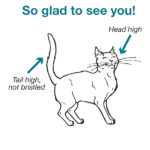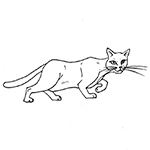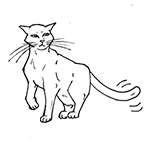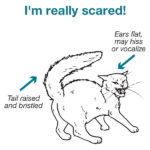If you were to believe internet videos like “Henri, le Chat Noir,” the mind of a cat is full of deep philosophical thoughts, soul-crushing ennui, and occasional plans for world domination. But, as we all know, just because the internet says so doesn’t make it true.
Everything is a matter of perception, and often it has little to do with what the cat is actually trying to communicate. Personifying her, while fine for some light fun, can be problematic when more serious situations arise. Failing to understand cats on their terms can create or escalate a stressful situation. The result? Perhaps you simply fail to provide the cat what she wants or needs from you. Or, at worst, you force her to react out of fear or uncertainty and hurt herself or others.
At Alley Cat Allies, our mission is to protect and improve the lives of cats. That includes ensuring everyone has a basic education in “cat.” Cat communication is a complex combination of scent, vocalization, and body language used by cats to express themselves. To keep things simple, let’s focus on cat body language, including tail movements, and behavior. These are among the most universal and visible ways a cat communicates.
Understanding how a cat is feeling and what she is trying to communicate to you can lead to a better relationship that is built on respect, and a more confident cat, no matter where you find her: at home, in a shelter or veterinary clinic, or outdoors. In fact, many veterinary practices have begun using Fear Free techniques to create a calming environment, including replacing hectic waiting rooms with quiet exam rooms and implementing slip-free surfaces, calming pheromone sprays (such as Feliway®), and other tactics to put cats at ease.
So remember, the next time your cat begins to lash her tail, it doesn’t mean she is plotting to take over the world. It just means she is uneasy, and perhaps you can do something to help make her more comfortable.
Then, you can both go back to happily watching the latest introspective art house film about a certain mustachioed cat.

Body Language: Tail is held high and is not bristled. Her head is held high and her ears are pointed in the direction of whatever she is looking at.
Translation: I’m happy and feeling good!
How to Help: To see this positive behavior more often, help make cats feel more confident in their environments. Keep a regular routine, limit the unexpected, and provide enrichment like plenty of playtime and some high perches.
 Body Language: Tail is curved down slightly and the cat is swiveling to point in different directions. She’s also crouching a bit lower to the ground as well.
Body Language: Tail is curved down slightly and the cat is swiveling to point in different directions. She’s also crouching a bit lower to the ground as well.
Translation: What’s going on here?
How to Help: These are the hallmarks of a cat who is still investigating the situation and the environment. To ease her anxiety, try moving slowly and speaking in a soft voice while she gets used to what is happening around her.
 Body Language: Tail is lashing back and forth. Her ears are flattened and aimed backwards, sometimes referred to as “airplane ears.”
Body Language: Tail is lashing back and forth. Her ears are flattened and aimed backwards, sometimes referred to as “airplane ears.”
Translation: I don’t like this, please give me space!
How to Help: Whatever the cat is experiencing in the moment, she doesn’t like it. Try to give her some space or provide her an escape route so she can get away from whatever is causing her distress.

Body Language: Tail is full and bristled. The cat is crouched low with her ears flattened and she’s hissing at times.
Translation: I’m terrified!
How to Help: This cat isn’t angry, she’s extremely frightened. A cat in this situation will enter fight or flight mode. She will try to escape, or lash out. Do not try to grab the cat as any unexpected movement will feel like an attack to her. Instead, allow her to hide and calm down.

